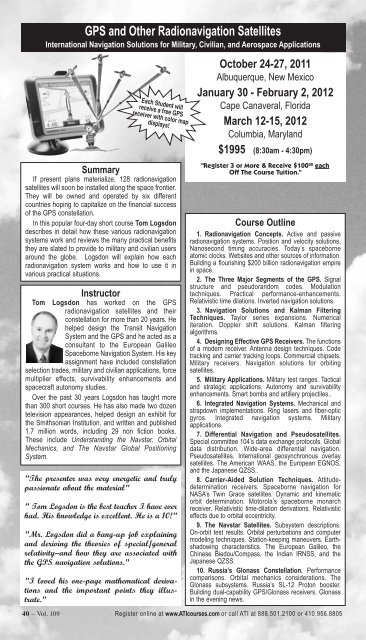Acoustics & Sonar Engineering Radar, Missiles & Defense Systems ...
Acoustics & Sonar Engineering Radar, Missiles & Defense Systems ...
Acoustics & Sonar Engineering Radar, Missiles & Defense Systems ...
You also want an ePaper? Increase the reach of your titles
YUMPU automatically turns print PDFs into web optimized ePapers that Google loves.
GPS and Other Radionavigation Satellites<br />
International Navigation Solutions for Military, Civilian, and Aerospace Applications<br />
Each Student will<br />
receive a free GPS<br />
receiver with color map<br />
displays!<br />
Summary<br />
If present plans materialize, 128 radionavigation<br />
satellites will soon be installed along the space frontier.<br />
They will be owned and operated by six different<br />
countries hoping to capitalize on the financial success<br />
of the GPS constellation.<br />
In this popular four-day short course Tom Logsdon<br />
describes in detail how these various radionavigation<br />
systems work and reviews the many practical benefits<br />
they are slated to provide to military and civilian users<br />
around the globe. Logsdon will explain how each<br />
radionavigation system works and how to use it in<br />
various practical situations.<br />
Instructor<br />
Tom Logsdon has worked on the GPS<br />
radionavigation satellites and their<br />
constellation for more than 20 years. He<br />
helped design the Transit Navigation<br />
System and the GPS and he acted as a<br />
consultant to the European Galileo<br />
Spaceborne Navigation System. His key<br />
assignment have included constellation<br />
selection trades, military and civilian applications, force<br />
multiplier effects, survivability enhancements and<br />
spacecraft autonomy studies.<br />
Over the past 30 years Logsdon has taught more<br />
than 300 short courses. He has also made two dozen<br />
television appearances, helped design an exhibit for<br />
the Smithsonian Institution, and written and published<br />
1.7 million words, including 29 non fiction books.<br />
These include Understanding the Navstar, Orbital<br />
Mechanics, and The Navstar Global Positioning<br />
System.<br />
"The presenter was very energetic and truly<br />
passionate about the material"<br />
" Tom Logsdon is the best teacher I have ever<br />
had. His knowledge is excellent. He is a 10!"<br />
"Mr. Logsdon did a bang-up job explaining<br />
and deriving the theories of special/general<br />
relativity–and how they are associated with<br />
the GPS navigation solutions."<br />
"I loved his one-page mathematical derivations<br />
and the important points they illustrate."<br />
October 24-27, 2011<br />
Albuquerque, New Mexico<br />
January 30 - February 2, 2012<br />
Cape Canaveral, Florida<br />
March 12-15, 2012<br />
Columbia, Maryland<br />
$1995 (8:30am - 4:30pm)<br />
"Register 3 or More & Receive $100 00 each<br />
Off The Course Tuition."<br />
Course Outline<br />
1. Radionavigation Concepts. Active and passive<br />
radionavigation systems. Position and velocity solutions.<br />
Nanosecond timing accuracies. Today’s spaceborne<br />
atomic clocks. Websites and other sources of information.<br />
Building a flourishing $200 billion radionavigation empire<br />
in space.<br />
2. The Three Major Segments of the GPS. Signal<br />
structure and pseudorandom codes. Modulation<br />
techniques. Practical performance-enhancements.<br />
Relativistic time dilations. Inverted navigation solutions.<br />
3. Navigation Solutions and Kalman Filtering<br />
Techniques. Taylor series expansions. Numerical<br />
iteration. Doppler shift solutions. Kalman filtering<br />
algorithms.<br />
4. Designing Effective GPS Receivers. The functions<br />
of a modern receiver. Antenna design techniques. Code<br />
tracking and carrier tracking loops. Commercial chipsets.<br />
Military receivers. Navigation solutions for orbiting<br />
satellites.<br />
5. Military Applications. Military test ranges. Tactical<br />
and strategic applications. Autonomy and survivability<br />
enhancements. Smart bombs and artillery projectiles..<br />
6. Integrated Navigation <strong>Systems</strong>. Mechanical and<br />
strapdown implementations. Ring lasers and fiber-optic<br />
gyros. Integrated navigation systems. Military<br />
applications.<br />
7. Differential Navigation and Pseudosatellites.<br />
Special committee 104’s data exchange protocols. Global<br />
data distribution. Wide-area differential navigation.<br />
Pseudosatellites. International geosynchronous overlay<br />
satellites. The American WAAS, the European EGNOS,<br />
and the Japanese QZSS..<br />
8. Carrier-Aided Solution Techniques. Attitudedetermination<br />
receivers. Spaceborne navigation for<br />
NASA’s Twin Grace satellites. Dynamic and kinematic<br />
orbit determination. Motorola’s spaceborne monarch<br />
receiver. Relativistic time-dilation derivations. Relativistic<br />
effects due to orbital eccentricity.<br />
9. The Navstar Satellites. Subsystem descriptions.<br />
On-orbit test results. Orbital perturbations and computer<br />
modeling techniques. Station-keeping maneuvers. Earthshadowing<br />
characteristics. The European Galileo, the<br />
Chinese Biedou/Compass, the Indian IRNSS, and the<br />
Japanese QZSS.<br />
10. Russia’s Glonass Constellation. Performance<br />
comparisons. Orbital mechanics considerations. The<br />
Glonass subsystems. Russia’s SL-12 Proton booster.<br />
Building dual-capability GPS/Glonass receivers. Glonass<br />
in the evening news.<br />
40 – Vol. 109 Register online at www.ATIcourses.com or call ATI at 888.501.2100 or 410.956.8805

















